| October
5, 2006
Hello from Nova Scotia – Local History
Discovered at the Yarmouth County Museum
On a dull drizzly morning I got a good start to my day with a filling
breakfast and an interesting interview with the innkeepers
of the MacKinnon-Cann in, followed by a tour of the four historic
heritage properties that they own. In addition to last night’s
walking tour of Yarmouth, I had now got
a good idea of Yarmouth’s Victorian architecture. Now it was
time to delve deeper into history, so I embarked on my visit of
the Yarmouth
County Museum and Archives.
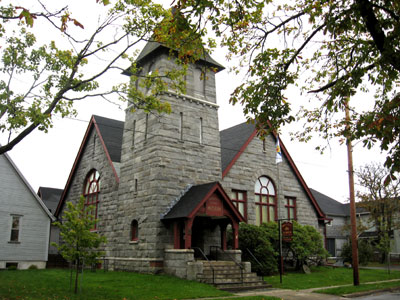
The Yarmouth County Museum
Nadine Gates, the curator, welcomed me and gave me a personal tour
throughout the facilities. As an overview she explained that the
Yarmouth County Museum is a good representation of Yarmouth’s
past. The town’s seafaring history is a major focus of the
museum which features the third largest collection of ship portraits
in Canada. More than 120 different ship portraits illustrate Yarmouth’s
historic importance in shipbuilding and navigation.
The Yarmouth County Historical Society was founded in 1967, and
the museum opened in 1969 in a former church building. Beautiful
wooden beams across a high vaulted ceiling demonstrate the former
ecclesiastical use of this building. The museum has been expanded
twice in 1999 and 2004. The new wing we were standing in is called
the Education Wing and hosts a variety of Historical Society meetings,
talks and lectures, music recitals and other events and is open
to the public. At the present time it is hosting a stained glass
exhibit that features local artists.
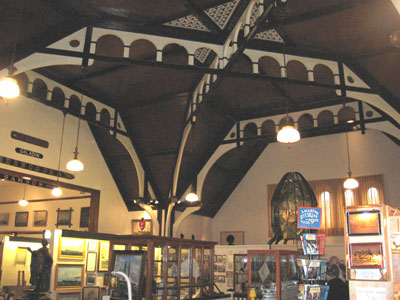
The main area is a former church
From the Education Wing we entered the main section of the museum
which is an impressive space with a very high ceiling. The main
exhibit area (the former church) still exudes a solemn atmosphere.
Nadine took me to an area called “Families at Sea”.
Throughout seafaring history, particularly at the beginning of the
previous century, entire families would be living on tall ships,
and souvenirs from their trips all over the world were displayed
here along with photos and letters of the various family members
whose permanent residence was a wooden vessel on the ocean. A certain
Catherine Ladd, for example, spent the first twelve years of her
life living on a ship, and her artifacts are available for viewing.
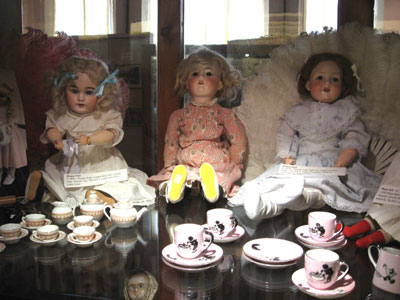
Victorian dolls and dishes
Nadine also gave me a general explanation of Yarmouth’s history.
The town was founded in the 1700s as an Acadian settlement whose
residents were deported in the mid 1800s as part of the Grand Expulsion.
Some Acadian settlers tried to escape deportation and hid in the
forest with the Mi’kmaq native tribe. United Empire Loyalists were then assigned the land, and their economy focused on ship-building.
This was the Golden Age of Sail, the Age of the Tall Ships. Today’s
economy is based on fishing, and in particular lobster fishing.
Interestingly, Nadine pointed out that years ago lobsters were only
eaten by poor people and often they were used as cheap fertilizer
in local gardens. How tastes change….
One area of the museum also features nameplates of ships. The most
prominent and well-known one is the nameplate of the “Samson”.
This ship was the closest ship to the sinking Titanic during the
cold April days of 1912, and she heard the mayday calls of the sinking
ocean liner. But because the Samson had been illegally fishing in
the waters off Eastern Canada, the crew chose not to answer the
distress call and left the area. We will never know how many more
people could have been saved if the Samson had responded to this
distress call. She was later renamed the “New York City”,
a name that is still visible on the other side of the nameplate.

The nameplate of the ominous "Samson"
The Yarmouth County Museum is located right in the heart of Yarmouth’s
Collins Street Heritage District. In addition to being a heritage
property itself, the museum is surrounded by dozens of large homes
owned formerly by wealthy sea captains and merchants. The Pelton-Fuller
House next door was built as a summer home between 1890 and 1895
as a mansion for Alfred Fuller, a wealthy merchant, and was donated
by one of his descendants in 1995 together with all its contents.
Today it is part of the museum complex and an example of Victorian
living.
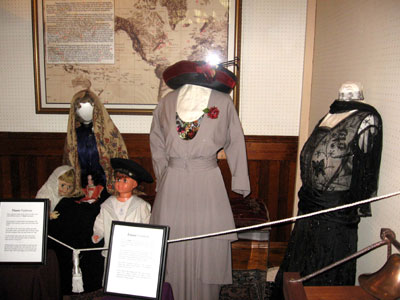
High Victorian fashion
The Yarmouth County Museum has another off-site satellite location:
the Killam Brothers Shipping Office is Canada’s oldest shipping
office. In 1788 John Killam built his first schooner and started
a family business that would span 203 years and five generations
of the Killam family. The property was also donated to the Yarmouth
County Historical Society, and the 19th century setting gives visitors
an idea of a commercial office of the 1900s.
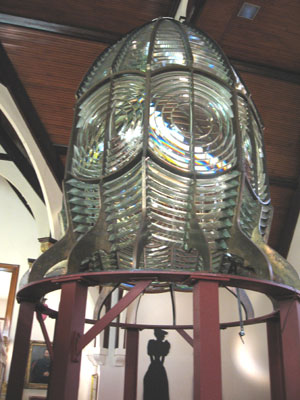
The former lens of the Cape Forchu Lighthouse
One of the highlights of the Yarmouth County Museum is the lens
of the Cape Forchu Lighthouse which dates back to 1908. The lens
weighs approximately 3300 pounds and has 360 prisms. It was built
in Paris, France, at a cost of $38,000 and was lit with kerosene.
The job of a lighthouse keeper was very strenuous since a heavy
tank of kerosene had to be carried up the narrow winding stairs
of the lighthouse every night. The original Cape Forchu Lighthouse
dating back to 1838 was replaced in 1962 at which time the lens
was replaced and donated to the Yarmouth County Historical Society.
A Victorian room features a variety of historical customs and dresses
as they would be worn by people about 120 years ago. Types of dress
of first class, second and third class passengers were on display
and speak to a time of great social divisions and class distinctions.
A temporary exhibit features the silhouettes of Victorian fashions.
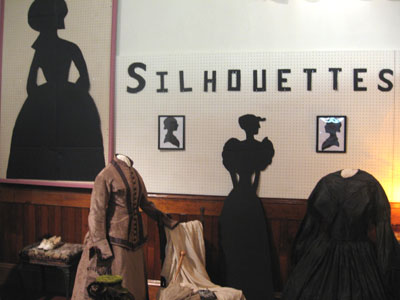
The Silhouttes of Victorian fashion
On the lower level of the museum various rooms display an early
1900s kitchen, a bedroom, and a nursery / toy room. These rooms
provide good insight into late Victorian home life. The next room
features industrial exhibits and machinery: a transmitter from a
radio station, a coffee grinder and a printing press illustrate
the evolution of mechanical equipment. A brass steam whistle from
the Cosmos Cotton Mills is an example of industrial equipment that
was used to call employees to work.
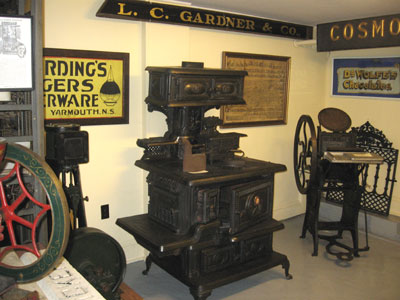
Industrial and commercial equipment
A room with various Nova Scotian wildlife scenes is followed by
a forge. The blacksmith used to be one of the most important people
in the village and his work environment is featured along with other
implements such as a yoke (the contraption fitted around a draught
animal’s necks where the plough would be attached). An early
Acadian loom is testimony to the craftsmanship that existed here
a few hundred years ago. A tool room features a foot-powered jig
saw. Today we can hardly imagine an existence without electricity.
Our ancestors were well-versed in the application of human or animal
power to propel various types of equipment.
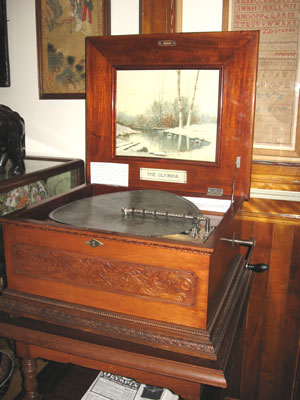
The Olympia Music Box
Several glass cases display antique glass and china collections
while Mi’kmaq artifacts and arrowheads provide insight into
native history and craftsmanship. Back upstairs we had a look at
the antique musical instrument collection of the Yarmouth County
Museum. Nadine demonstrated the Olympia Music Box, a device from
1898 that uses zinc disks for each song. A barrel with teeth plucks
the various notes, propelled by a spring-loaded mechanism.
The musical instruments section was a real highlight of the museum
and Nadine mentioned that usually they demonstrate three of the
instruments to visitors. A Concert Roller Organ from 1902 is an
example of some of the mechanical instruments that were used long
ago. This device, patented in 1887, is operated by cranking the
external handle. The internal bellows, tuned reeds, valves and a
roller produce organ-like tones. The Square Grand Piano dates back
to 1874 and a Player Organ from 1890 is also on display.
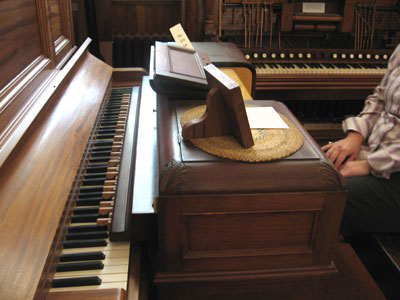
The Pianola Player Piano: little hammers strike the piano's keys
My favourite instrument was the Pianola Player Piano, manufactured
in 1902: the rectangular box is pedal-operated, and a set of tiny
hammers at the back strikes the keys of a Guild “Square Grand”
piano made in Boston in 1874. The Player Piano could simply be pushed
up to any piano, and even a person who had never played the piano
before could make beautiful music. All they had to do was to push
the foot pedals up and down. Nadine played the 1920s tune “The
Entertainer”, the music itself is recorded on perforated paper
rolls which actually looked rather fragile to me. The foot pedals
operate a bellows system that operates the little hammers that play
the tune on the piano behind it. What an ingenious invention….
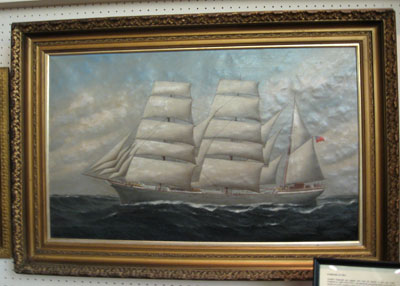
One of the many ship portraits
A small display area is dedicated to the Yarmouth militia, attesting
to Yarmouth’s history as a military training ground during
World War II. All throughout this wing of the museum numerous ships
portraits depict impressive tall ships of years gone by. The ship
owners would commission these paintings because once these ships
were built and commissioned, they hardly ever came back to town,
and in many cases the owners would never see the ships again.
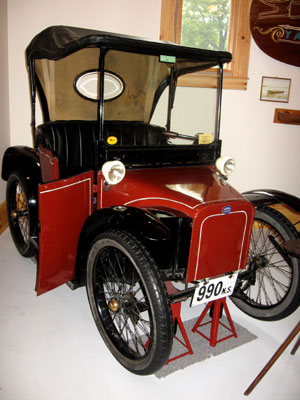
The electric car, note the license plate: 990 N.S. (Nova Scotia)
We ended our tour in the new section where there is a collection
of stage coaches, bicycles and other vehicles. One of the highlights
in this area is the 1921 electric car of a certain Minnie L. Lovitt,
who was the first female driver in Yarmouth. She must have turned
a lot of heads at the time. My guided tour had come to an end and
I thanked Nadine for sharing her knowledge with me and got ready
for my trip along the famous Lighthouse
Trail where I would experience a
significant incident that helped me gain important insight into
the local mentality.
Useful books about travel to Nova Scotia:
Related articles:
My five whirlwind days in
Nova Scotia
Acadian
history at the Grand Pré National Historic Site
400 years of history at Annapolis
Royal
Port-Royal, a French habitation from 1605
Dinner at the Garrison House
in Annapolis Royal
The Annapolis Royal
Graveyard Tour
The Garrison House Bed and Breakfast
Exploring the Evangeline Trail from
Annapolis Royal to Yarmouth
Learning about Mi'kmaq heritage at the
Bear River First Nation Heritage and Cultural Center
Victorian heritage in Yarmouth
The MacKinnon-Cann Inn: Where Home
and Garden Television meets the Travel Channel
Yarmouth explained - the Yarmouth
County Museum
My car is in the ditch in Chebogue
River
The Lighthouse Trail from Yarmouth
to Shelburne
The Lighthouse Trail from Shelburne
to Lunenburg
The Town of Lunenburg - a UNESCO World Heritage
Site
An interview with the owners of the
Lunenburg Inn
The Lighthouse Trail from Lunenburg to
Halifax via Mahone Bay and Peggy's Cove
Arrival in Halifax and a stunning
musical performance - DRUM!
A Halifax city tour, the city's
connection to the Titantic and the 1917 Halifax Explosion
Exploring the Halifax Harbourwalk and
Pier 21 - Canada's immigration museum
A ferry trip to Dartmouth and saying
goodbye to Halifax
An interview with Pier 21 -
Canada's immigration museum
Helpful links for travel to Nova Scotia:
Tourism
Nova Scotia
Destination
South West Nova Scotia
Halifax Tourism
|